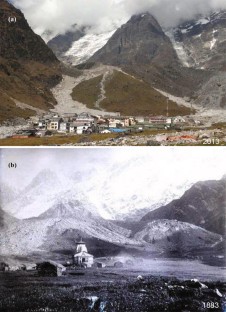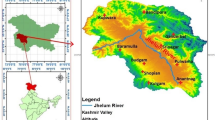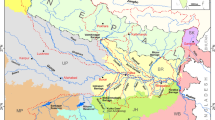Abstract
Kedarnath was devastated on 16th evening–17th morning (June 2013) due to landslides and flash floods that killed more than 5000 people in Uttarakhand. What really happened on 16th evening through next 12 h till final deluge on 17th morning has been a subject of speculation due to lack of sufficient eye witness and monitoring system. Earth observation techniques have provided information on precipitation, landslides, snow cover and other ancillary data such as digital elevation models at varying resolution. Using such spatial information along with limited eye witness and media reports, an attempt is made to reconstruct events that led to destruction in upper Mandakini valley with prime aim to improve response and minimise damage in the event of similar disaster in future. The study has revealed that there were two distinct events separated by a time gap of 10–12 h: the first event was triggered by series of landslides, river blockades, breaching, flooding and river bank failures, whereas the second event was mainly associated with Chorabari Tal Lake outburst flooding along with associated landslides and bank erosion. Comprehensive assessment of landslide hazard requires process-based modelling using numerical simulation methods. The present study aims to focus on analysis of landslides/debris flow movements and simulate landslides that occurred in Kedarnath event leading to derivation of important flow parameters to get closer to the root cause of the devastation. The unique geomorphological setting, which has changed significantly in the recent event, provides valuable inputs for critical assessment of damage and remedial measures in future. Comparison with Gohna Tal (in Birahi Ganga, a tributary of Alaknanda) landslide lake outburst flooding has provided closer insight on the event and it revealed how preparedness can reduce the impact of such natural disasters.







Similar content being viewed by others
References
Ayotte D, Hungr O (2000) Calibration of a runout prediction model for debris flows and avalanches. In: Wieczorek GF, Naeser ND (eds) Proceedings of 2nd international conference on debris flows, Taipei. Balkema, Rotterdam, pp 505–514
Bhandari RK (2003) Two great landslide tragedies of India. In: Gupta H (ed) Disaster management. University Press (India) Pvt. Ltd., Hyderabad, pp 110–126
Christen MK, Walski J, Bartelt P (2010) Ramms: numerical simulation of dense snow avalanches in three-dimensional terrain. Cold Reg Sci Technol 63(1/2):1–14
Dimri VP (2013) Uttarakhand had early warning communication in 1894. Curr Sci 105(2):152
Dobhal DP, Gupta AK, Mehta M, Khandelwal DD (2013) Kedarnath disaster: facts and plausible causes. Curr Sci 105(2):171–174
Evans SG, Delaney KB, Hermanns RL, Strom A, Mugnozza GS (2011) The formation and behaviour of natural and artificial rockslide dams; implications for engineering performance and hazard management. In: Evans SG, Hermanns RL, Strom A, Mugnozza GS (eds) Natural and artificial rockslide dams. Springer, New York, pp 1–76
Glass JH (1896) The great landslip at Gohna, in Garhwal, and the measures adopted to prevent serious loss of life. J Soc Arts 44:431–445
Gupta AC (1974) Lakes of sorrow. J Civil Eng (Ind) 58:6–11
Heim A, Gansser A (1939) Central Himalaya: geological observations of the swiss expedition 1936. Hindustan Publishing Corporation, New Delhi
Holland TH (1894) Report on the Gohna Landslip, Garhwal. Rec Geol Surv India 27:55–65
Hungr O, Morgan GC, Kellerhals R (1984) Quantitative analysis of debris torrent hazards for design of remedial measures. Can Geotech J 21:663–677
Lubbock G (1894) Gohna Lake. Geogr J 4:457
Mehta M, Majeed Z, Dobhal DP, Srivastava P (2012) Geomorphological evidences of post-LGM glacial advances in the Himalaya: a study from Chorabari Glacier, Garhwal Himalaya, India. J Earth Syst Sci 121(1):149–163
Pratt-Sitaula B, Garde M, Burbank DW, Oskin M, Heimsath A, Gabet E (2007) Bedload to suspended load ratio and rapid bedrock incision from Himalayan landslide-dam lake record. Quat Res 68:111–120
Rickenmann D (1994) An alternative equation for the mean velocity in gravel-bed rivers and mountain torrents. In: Cotroneo GV, Rumer RR (eds) In: Proceedings ASCE 1994 national conference on hydraulic engineering, vol 1. Buffalo NY, USA, pp 672–676
Rickenmann D (1999) Empirical relationships for debris flows. Nat Hazards 19:47–77
Rickenmann D (2005) Runout prediction methods. In: Jakob M, Hungr O (eds) Debris-flow hazard and relation phenomena. Springer, Chichester, pp 305–324
Salm B, Burkhard A, Gubler HU (1990) Berechnung von Fliesslawinen: eine Anleitungfuer Praktiker; mit Beispielen. Mitteilungen des Eidgenoessischen Instituts fuerSchnee- und Lawinenforschung 47:1–37
Singh SP, Singh VK, Saklani PS (1997) Metamorphism in the central crystalline of higher Himalaya in Kedarnath valley, Garhwal Himalaya, UP. Him Geol 18:119–133
The Imperial Gazetteer of India (1908) Vol XII, Einme to Gwalior, Clarendon Press, Oxford, p 458
Valdiya KS, Paul SK, Chandra T, Bhakuni SS, Upadhyay RC (1999) Tectonic and lithological characterization of Himadri (Great Himalaya) between Kali and Yamuna rivers, Central Himalaya. Him Geol 20(2):1–17
Vuichard D, Zimmerman M (1987) The 1985 catastrophic drainage of a moraine-dammed lake, Khumbu Himal, Nepal: cause and consequence. Mt Res Dev 7(2):91–110
Weidinger JT (1998) Case history and hazard analysis of two lake-damming landslides in the Himalayas. J Asian Earth Sci 16(2–3):323–331
Xu D (1988) Characteristics of debris flow caused by outburst of glacier lake in Boqu River, Xizang, China. Geo J 17(4):569–580
Acknowledgments
Authors are thankful to Mr. V. K. Singh, M. Tech student, for data collection during field visit to Gohna Tal Lake in 2004, IIRS team (Dr. Praveen Thakur, Mr. Shishant Gupta, M. Tech student, Mr. Amit Anand, M. Sc. (NHDRM) student) for sharing field information and Dr. D. P. Dobhal, Scientist, WIHG for useful discussion on Chorabari Tal Lake breach and devastation in Kedarnath town. Overall support and encouragement received from Dr. A. Senthil Kumar, Director, IIRS is duly acknowledged. Encouragement received from former Director and Dean (Acad) of IIRS is also placed on record. The authors are thankful to the anonymous reviewers for constructive criticisms and careful editing of the earlier versions of the manuscript.
Author information
Authors and Affiliations
Corresponding author
Rights and permissions
About this article
Cite this article
Champati Ray, P.K., Chattoraj, S.L., Bisht, M.P.S. et al. Kedarnath disaster 2013: causes and consequences using remote sensing inputs. Nat Hazards 81, 227–243 (2016). https://doi.org/10.1007/s11069-015-2076-0
Received:
Accepted:
Published:
Issue Date:
DOI: https://doi.org/10.1007/s11069-015-2076-0




